英译汉教程chapter 3-Diction
- 格式:ppt
- 大小:1.04 MB
- 文档页数:35
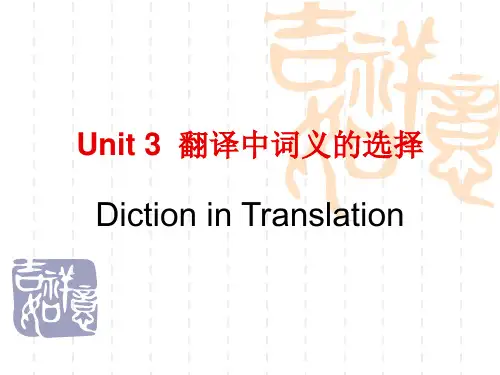
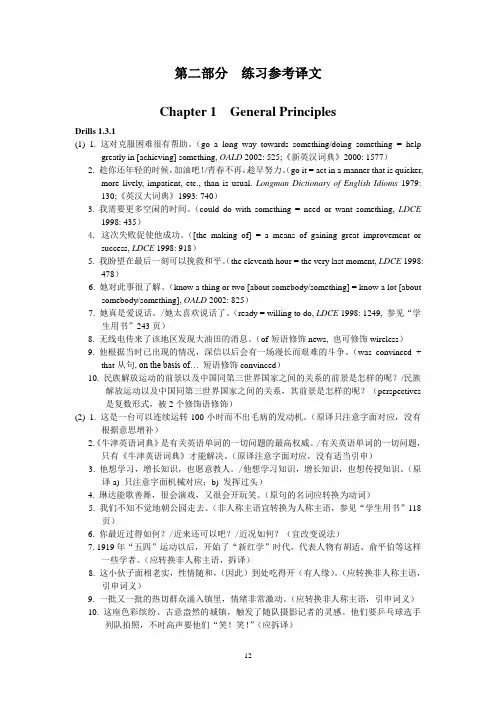
第二部分练习参考译文Chapter 1 General PrinciplesDrills 1.3.1(1) 1. 这对克服困难很有帮助。
(go a long way towards something/doing something = helpgreatly in [achieving] something, OALD 2002: 525;《新英汉词典》2000: 1577)2. 趁你还年轻的时候,加油吧!/青春不再,趁早努力。
(go it = act in a manner that is quicker,more lively, impatient, etc., than is usual. Longman Dictionary of English Idioms1979: 130;《英汉大词典》1993: 740)3. 我需要更多空闲的时间。
(could do with something = need or want something, LDCE1998: 435)4. 这次失败促使他成功。
([the making of] = a means of gaining great improvement orsuccess, LDCE 1998: 918)5. 我盼望在最后一刻可以挽救和平。
(the eleventh hour = the very last moment, LDCE 1998:478)6.她对此事很了解。
(know a thing or two [about somebody/something] = know a lot [aboutsomebody/something], OALD 2002: 825)7. 她真是爱说话。
/她太喜欢说话了。
(ready = willing to do, LDCE 1998: 1249, 参见“学生用书”243页)8.无线电传来了该地区发现大油田的消息。
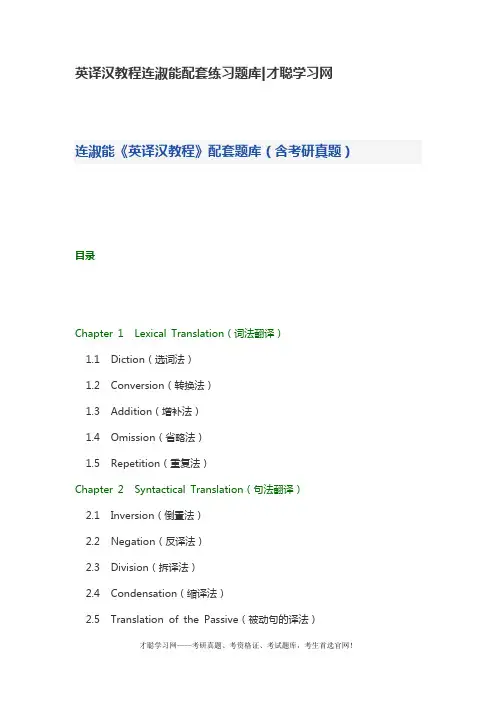
英译汉教程连淑能配套练习题库|才聪学习网连淑能《英译汉教程》配套题库(含考研真题)目录Chapter 1 Lexical Translation(词法翻译)1.1 Diction(选词法)1.2 Conversion(转换法)1.3 Addition(增补法)1.4 Omission(省略法)1.5 Repetition(重复法)Chapter 2 Syntactical Translation(句法翻译)2.1 Inversion(倒置法)2.2 Negation(反译法)2.3 Division(拆译法)2.4 Condensation(缩译法)2.5 Translation of the Passive(被动句的译法)2.6 Translation of Long Sentences(长句译法)Chapter 3 Translation of cultural factors(文化因素的翻译)3.1 Translation of Culture-loaded Expressions(文化词语译法)3.2 Translation of Proper Nouns and Technical Terms(专有名词和专门术语译法)Chapter 4 Style and Translation(文体与翻译)4.1 Political Writing(政治文体)4.2 Journalistic Writings(新闻报刊文体)4.3 Popular Science Writing(科普文体)4.4 Practical Writing(应用文体)4.5 Literary Style(文学文体)•试看部分内容Chapter 1Lexi cal Transla tion(词法翻译)1.1 Diction(选词法)Ⅰ. Choice of Affective Meanings1. In ou r Se con d Addre ss on the war, fi ve days af te rt h e a d v e n t o f th o s e m e n,w e to l d y o u w h a t th e y w e r e.【译文】在这伙人上台五天以后,我们在关于前次战争的第二篇宣言中已经向你们说明他们究竟是些什么货色了。
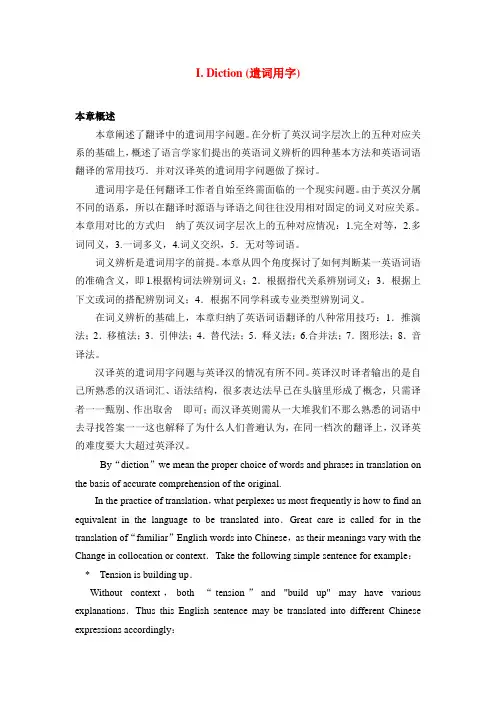
I. Diction (遣词用字)本章概述本章阐述了翻译中的遣词用字问题。
在分析了英汉词字层次上的五种对应关系的基础上,概述了语言学家们提出的英语词义辨析的四种基本方法和英语词语翻译的常用技巧.并对汉译英的遣词用字问题做了探讨。
遣词用字是任何翻译工作者自始至终需面临的一个现实问题。
由于英汉分属不同的语系,所以在翻译时源语与译语之间往往没用相对固定的词义对应关系。
本章用对比的方式归纳了英汉词字层次上的五种对应情况:1.完全对等,2.多词同义,3.一词多义,4.词义交织,5.无对等词语。
词义辨析是遣词用字的前提。
本章从四个角度探讨了如何判断某一英语词语的准确含义,即l.根据构词法辨别词义;2.根据指代关系辨别词义;3.根据上下文或词的搭配辨别词义;4.根据不同学科或专业类型辨别词义。
在词义辨析的基础上,本章归纳了英语词语翻译的八种常用技巧:1.推演法;2.移植法;3.引伸法;4.替代法;5.释义法;6.合并法;7.图形法;8.音译法。
汉译英的遣词用字问题与英译汉的情况有所不同。
英译汉时译者输出的是自己所熟悉的汉语词汇、语法结构,很多表达法早已在头脑里形成了概念,只需译者一一甄别、作出取舍即可;而汉译英则需从一大堆我们不那么熟悉的词语中去寻找答案一一这也解释了为什么人们普遍认为,在同一档次的翻译上,汉译英的难度要大大超过英泽汉。
By“diction”we mean the proper choice of words and phrases in translation on the basis of accurate comprehension of the original.In the practice of translation,what perplexes us most frequently is how to find an equivalent in the language to be translated into.Great care is called for in the translation of“familiar”English words into Chinese,as their meanings vary with the Change in collocation or context.Take the following simple sentence for example:* Tension is building up.Without context,both “tension”and "build up" may have various explanations.Thus this English sentence may be translated into different Chinese expressions accordingly:·形势紧张起来。
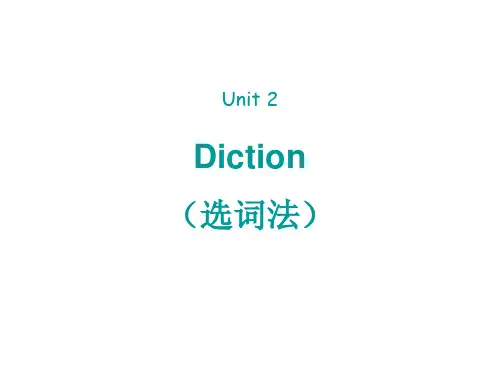
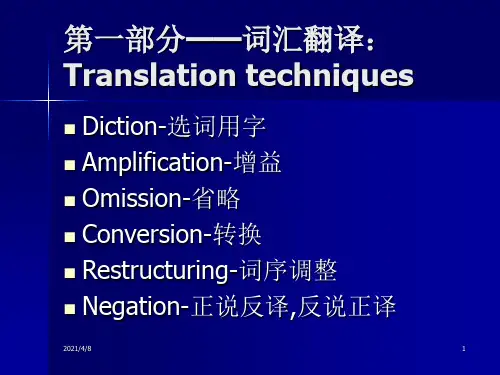
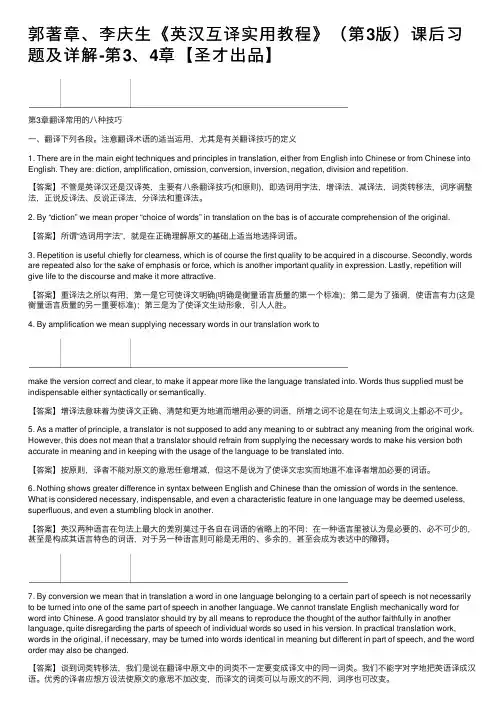
郭著章、李庆⽣《英汉互译实⽤教程》(第3版)课后习题及详解-第3、4章【圣才出品】第3章翻译常⽤的⼋种技巧⼀、翻译下列各段。
注意翻译术语的适当运⽤,尤其是有关翻译技巧的定义1. There are in the main eight techniques and principles in translation, either from English into Chinese or from Chinese into English. They are: diction, amplification, omission, conversion, inversion, negation, division and repetition.【答案】不管是英译汉还是汉译英,主要有⼋条翻译技巧(和原则),即选词⽤字法,增译法,减译法,词类转移法,词序调整法,正说反译法、反说正译法,分译法和重译法。
2. By “diction” we mean proper “choice of words” in translation on the bas is of accurate comprehension of the original.【答案】所谓“选词⽤字法”,就是在正确理解原⽂的基础上适当地选择词语。
3. Repetition is useful chiefly for clearness, which is of course the first quality to be acquired in a discourse. Secondly, words are repeated also for the sake of emphasis or force, which is another important quality in expression. Lastly, repetition will give life to the discourse and make it more attractive.【答案】重译法之所以有⽤,第⼀是它可使译⽂明确(明确是衡量语⾔质量的第⼀个标准);第⼆是为了强调,使语⾔有⼒(这是衡量语⾔质量的另⼀重要标准);第三是为了使译⽂⽣动形象,引⼈⼈胜。
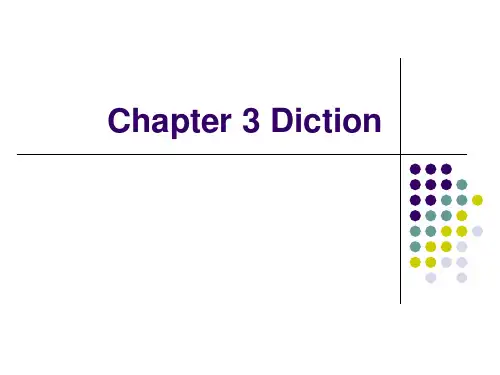
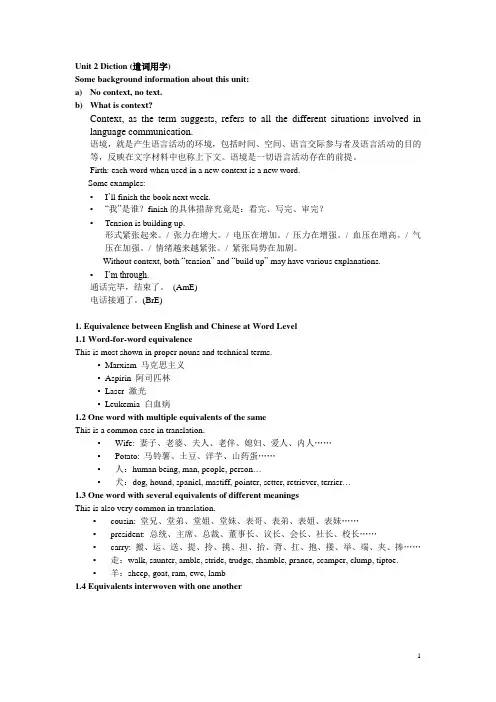
Unit 2 Diction (遣词用字)Some background information about this unit:a)No context, no text.b)What is context?Context, as the term suggests, refers to all the different situations involved in language communication.语境,就是产生语言活动的环境,包括时间、空间、语言交际参与者及语言活动的目的等,反映在文字材料中也称上下文。
语境是一切语言活动存在的前提。
Firth: each word when used in a new context is a new word.Some examples:▪I’ll finish the book next week.▪“我”是谁?finish的具体措辞究竟是:看完、写完、审完?▪Tension is building up.形式紧张起来。
/ 张力在增大。
/ 电压在增加。
/ 压力在增强。
/ 血压在增高。
/ 气压在加强。
/ 情绪越来越紧张。
/ 紧张局势在加剧。
Without context, both “tension” and “build up” may have various explanations.▪I’m through.通话完毕,结束了。
(AmE)电话接通了。
(BrE)1. Equivalence between English and Chinese at Word Level1.1 Word-for-word equivalenceThis is most shown in proper nouns and technical terms.▪Marxism 马克思主义▪Aspirin 阿司匹林▪Laser 激光▪Leukemia 白血病1.2 One word with multiple equivalents of the sameThis is a common case in translation.▪Wife: 妻子、老婆、夫人、老伴、媳妇、爱人、内人……▪Potato: 马铃薯、土豆、洋芋、山药蛋……▪人:human being, man, people, person…▪犬:dog, hound, spaniel, mastiff, pointer, setter, retriever, terrier…1.3 One word with several equivalents of different meaningsThis is also very common in translation.▪cousin: 堂兄、堂弟、堂姐、堂妹、表哥、表弟、表姐、表妹……▪president: 总统、主席、总裁、董事长、议长、会长、社长、校长……▪carry: 搬、运、送、提、拎、挑、担、抬、背、扛、抱、搂、举、端、夹、捧……▪走:walk, saunter, amble, stride, trudge, shamble, prance, scamper, clump, tiptoe.▪羊:sheep, goat, ram, ewe, lamb1.4 Equivalents interwoven with one another1.5 Words without corresponding equivalentsIn this case, an explanation is given instead of an equivalent.▪teenager: 13到19岁的青少年▪cyber slacker: 利用工作时间在公司上网、做与工作无关的事情的雇员▪阴:yin (in Chinese thought) the soft inactive female principle or force in the world▪阳:yang (in Chinese thought) the strong active male principle or force in the world2. Methods of discriminating the original meaning of a given word2.1 According to word formation▪parabiospheric: 外生物层的para- (outside), bio- (biologic), spheric (having the form of a phere)▪pneumonoultramicroscopicsilicovolcanokoniosis 肺尘病,硅酸盐沉着病pneumono (of lung) ultra (beyond) micro (very small)scopic (of viewing or observing) silico (of silicon) volcano (of volcano)coni (koni, of dust) osis (forming the name of a disease)2.2 According to the referenceIn many cases the meaning of a pronominal word may be judged from the references.▪He [father] sent John to the university and was eager to have him distinguish himself.他送约翰上大学,巴望儿子能出类拔萃。
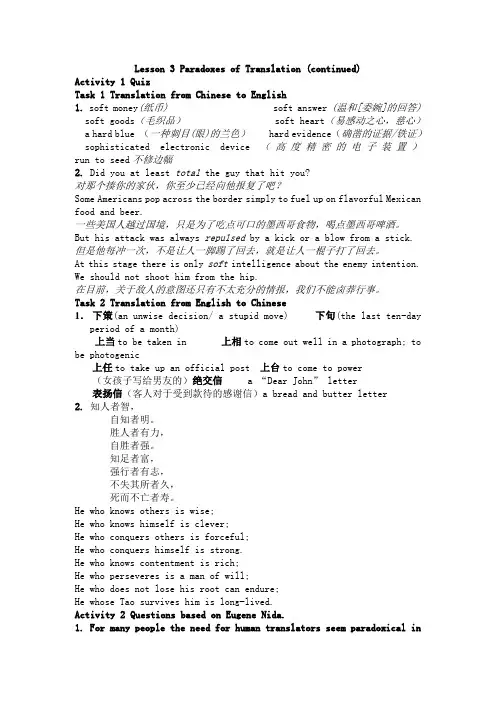
Lesson 3 Paradoxes of Translation (continued)Activity 1 QuizTask 1 Translation from Chinese to English1. soft money(纸币) soft answer (温和[委婉]的回答) soft goods(毛织品) soft heart(易感动之心,慈心)a hard blue (一种刺目(眼)的兰色) hard evidence(确凿的证据/铁证)sophisticated electronic device (高度精密的电子装置)run to seed不修边幅2. Did you at least total the guy that hit you?对那个揍你的家伙,你至少已经向他报复了吧?Some Americans pop across the border simply to fuel up on flavorful Mexican food and beer.一些美国人越过国境,只是为了吃点可口的墨西哥食物,喝点墨西哥啤酒。
But his attack was always repulsed by a kick or a blow from a stick. 但是他每冲一次,不是让人一脚踢了回去,就是让人一棍子打了回去。
At this stage there is only soft intelligence about the enemy intention. We should not shoot him from the hip.在目前,关于敌人的意图还只有不太充分的情报,我们不能卤莽行事。
Task 2 Translation from English to Chinese1.下策(an unwise decision/ a stupid move) 下旬(the last ten-day period of a month)上当to be taken in 上相to come out well in a photograph; to be photogenic上任to take up an official post 上台to come to power(女孩子写给男友的)绝交信 a “Dear John” letter表扬信(客人对于受到款待的感谢信)a bread and butter letter2. 知人者智,自知者明。
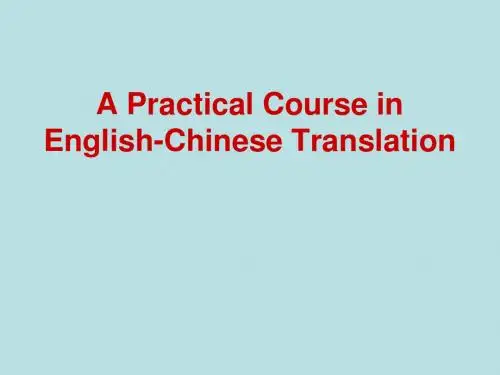
Chapter 3 翻译的过程翻译的过程是正确理解原文和创造性地用另一种语言再现原文的过程,大体上可分为理解、表达和校核三个阶段。
在翻译实践中,理解是表达的前提,但理解与表达通常是互相联系、往返反复的统一过程,不能截然分开。
在理解的时候,译者已自觉或不自觉地在挑选表达手段;在表达的时候,又进一步加深了理解。
在处理句子、段落或文章时,译者往往要从英语到汉语,从汉语到英语,反复推敲,仔细研究。
1 理解阶段——基础和关键理解(comprehension)可分为广义理解和狭义理解。
广义理解指对原文作者的个人、原文产生的时代背景、作品的内容以及原文读者对该作品的反映。
狭义的理解仅指对原作文本的理解。
对原文透彻的理解是确切翻译的第一步,也是翻译全过程最重要的一步。
正确的理解有助于正确的表达,而正确的理解取决于译者能否对原文进行深入细致的语法分析grammatical analysis、语义分析semantic analysis、语体分析stylistic analysis和语篇分析text analysis。
1.1语法分析——从语法的角度去剖析原文里句子的语法结构,弄清句子所传递的意义。
1.She recalled faintly an ecstasy of pain, the heavy odor of chloroform, a stupor which had deadened sensation, and an awakening to find a little new life to which she had given being, added to the great unnumbered multitude of souls that come and go.(重复译法)她模糊地回想起当时极度的痛苦,想起了浓烈的三氯甲烷麻醉剂的气味;她记得自己失去了知觉,昏了过去,而醒来时发现自己又为来来往往的芸芸众生增添了一条小小的新生命。
Diction 3Drill 3.1(1)crowd: 人群mod:(常贬)成群的暴徒praise:称赞,赞扬,表扬,赞美,崇拜boast:(贬义)夸口,自夸,吹嘘,自吹自擂;(非贬义)自豪,夸耀steadfast:(褒义)不动摇的,坚定不移的,忠实的;固定不动的obstinate:顽固的,固执的,倔强的;顽强的,不屈服的,不让步的deep dealings:不正当的交易a deep dealer:造诣深的学者childlike:(常褒义)孩子般的,单纯的,天真无邪的childish:(贬义)幼稚的,傻气的,不成熟的ststesman:(通常褒义)政治家politician:政客,善于玩弄权术的人;(中性)政治家(2)peasant:(贬义)a person without education or good mannesr; a person with rough unrefined manners无教养的人,粗野的人,乡下人,土包子,大老粗;(现时尤其指发展中国家或从前的)农民,农夫,雇农农民:(无贬义)在农村从事农业生产的劳动者Propaganda:(通常贬义)information that is spread in a planned or offcial way ,esp. by a government ,in order to influence public opinion宣传宣传:(无贬义)对群众说明讲解,使群众相信并跟着行动Compromise:(中性,无消极意义)settling an argument or diffence of opinion by each side agreeing to some of the demands of the other 通过互让解决争执或分歧,互让了结,妥协,折中,和解妥协:(有时有消极意义)用让步的方法避免冲突或争执Dragon:an imaginary animal with wings and claws,able to breathe out fire,(比喻贬义)a fierce person ,esp.a woman比喻凶恶的人,尤指悍妇龙:中国古代传说中的神异动物,身体长,有鳞,有角,有脚,能走,能飞,能游泳,能兴云降雨:封建时代用龙作为帝王的象征,也把龙用在帝王使用的东西上:比喻有褒义,如“望子成龙”、”龙腾虎跃”goat:(比喻贬义)a man who is very ative sexually色鬼,好色之徒,色狼山羊:无褒贬之意W est wind: 英国人对西风有好感,如英国诗人著名的名诗《西风颂》西风:(比喻贬义)日趋没落的腐朽势力(3)1.英雄的事迹是极为动人的。
1待走读生好点克里斯托夫·M·贝利托你也许可以列出往宿家中,每天赫家和学校之间的大学走读生所享受的种森!} l}越之处。
_但在下面的文章中,作者试图揭示事‘清的另一面,认为走读生的生活并不如人}l !}们想像中的那般轻松。
走读生过着一种矛盾的生活,他去学校是为了能体会一种自我探}l l}索的生活,而实际上与父母在一起是绝对无法保持“我独立的。
你也许认为我们这些人住在家中、每天往返学校的日子很惬意。
不用等洗衣机,牙膏用完了橱拒里有新的,更重要的是,冰箱里塞满了食物,也不用自己付款。
不仅如此,通常还有人付电话费,即使再晚,微波炉里也还热着食物。
你会嗤之以弃—那不是大学生活,那只是永远长不大的孩子。
也许表面上看起来我们像被惯坏了的孩子,但事情远没有那么简单。
住在家里的大学生过着一种矛盾的生活。
跟你们一样,我们来到大学探索自我;自我探索和有机化学一样是我们所受教育的一部分。
然而,鉴于父母监督子女的本能不会减弱,我们要保持自我独立可就不容易了。
再者,家庭的责任也在所难免。
比方说,当父母的结婚周年纪念日正好在我们期末考试的前一天,我们该怎么办?事实上,做一个无法脱离家庭约束的学生简直与努力跟一个你不喜欢的室友相处一样困难。
我们的问题很复杂。
在一定程度上,我们是这个社会的二等公民。
由于你不得不开车回家或赶最后一班车,你很难享受俱乐部、大学生联谊会和舞会的乐趣。
同样不幸的是,你意识到你不能参加仅有一次的商法复习课,因为它结束得太晚。
但这还不是问题的关健:毕竟,每个人都可以随时在朋友的宿舍里借宿。
’真正的问题在于,我们错过了那些活动,错过了由此产生的一种友好的情嗦,这种情嗦来自于一同突击恶补工业心理学的漫漫长夜,来自于谁跟谁上了床的瞎扯闲铆,来自于关于“乔治·威尔”和“亲爱的艾比”的热门话题,以及在这之后彼此对于毕业临近的真切感受的交流。
诚然,我们走读生也可以偶尔参与这些活动,但我们跟不上大学学术生活的日夜节奏。